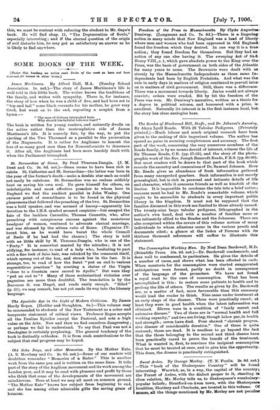St. Bernardine of Siena. By Paul Thureau-Dangin. (J. M. Dent
and Co. 3s. 6d. net.)—Siena seems to have been rich in saints. St. Catherine and St. Bernardino—the latter was born in the year of the former's death—make a double star such as could not easily be outshone. St. Bernardino was no recluse selfishly bent on saving his own soul. He gave himself for others, an indefatigable and most effective preacher to whom here in England we find the readiest parallel in John Wesley. One curieue point of resemblance is to be found in the physical phenomena that followed the preaching of the two. St. Bernardine was a bold speaker, and was accused of heresy—apparently his devotion to the I.H.S. symbol aroused suspicion—but escaped the fate of the luckless Carmelite, Thomas Connette, who, after preaching with conspicuous success against the monstrous headgear of women, ventured to advocate clerical marriage, and was silenced by the uttinta ratio of Rome. (Eugenius IV. burnt him, as he would have burnt the whole Council of Basle if he had had the chance.) The story is told with ne little skill by M. Thureau-Dangin, who is one of the "Forty." It is somewhat marred by the miracles ; it is not edifying, ter instance, to read of a lady who, hesitating to part with a fine lock of false hair, was rebuked by the ornament itself, which sprang out of the box, and struck her in the face. It is strange, too, to read of how the Saint "put an end to various superstitious practices" by erecting a statue of the Virgin "close to a fountain once sacred to Apollo." But were they " put an end to" I' Many of these ecclesiastical victories over paganism are more than doubtful. The translation is by the Baroness G. von Hugel, and reads easily enough. " Riled " (p. 21), we may remark, has not yet made its way into the literary language.


















































 Previous page
Previous page